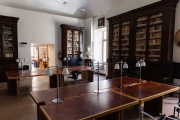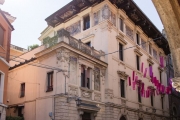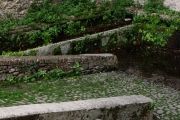

The small church of Sant’Anna relates the architectural history of the Aprutina (Abruzzi) Diocese and is probably the oldest one in Abruzzo. Inside, a keen eye will be able to grasp the architectural and artistic aspects which reflect the historical events and architectonic development of the entire religious complex of the ancient Cathedral of S. Maria Aprutiensis. This little jewel is the result of the stratification of elements dating back to its origins until today and must probably still be explored and understood fully. It tells us about the origins of early Christianity in the Roman city of Interamnia Praetut(t)iorum, about the Diocese in late antiquity in Aprutium, of Teramum and about modern Teramo.

The existence of a Christian community in Interamnia was already known to exist under Pope Eleuterio at the end of the 2nd century. In addition, it is probably no coincidence that it was named after San Getulio, before being readapted in the 1700s into a private chapel belonging to the affluent De ‘Pompetti family and dedicated to Sant’Anna. San Getulio was a proto-martyr saint from the nearby Sabine area who was martyred under the emperor Hadrian between 117 and 138. The oldest documents that attest the existence of the bishopric in Late Antiquity in Teramo, Castrum Aprutiense, are three letters written by Pope Gregory the Great between 598 and 601. The earliest evidence that the Cathedral of Aprutium was named after the Virgin, S. Maria Aprutiensis, is reported in a document dated 897 in the Cartulario della chiesa teramana (cartulary of the Teramo church).
The cathedral was almost completely destroyed in the Norman fire of 1157 (1156) caused by Count Roberto of Loretello.


The first historian and researcher to address the problem of understanding the construction phases that we know of was the archaeologist from Teramo, Francesco Savini, who published his archaeological research in 1898. The architectural historian, Carlo Ignazio Gavini, in his famous History of Architecture in Abruzzo dated 1926, remains to this day the most lucid interpreter of the building and architectural facts that can be observed in situ, apart from the results of the excavations carried out in the eighties of the last century.

Going down the stairs to enter the small church, visitors will immediately be surprised by the evident contrast between the extreme simplicity of the outside of the building, which looks almost like a rural church, and the overwhelming structure of the internal architecture.
An attentive observer will immediately realize that descending to reach the lower floor levels, that coincide with those of the early Christian Basilica found outside, means taking a leap into the history of this site and observing architectural details that, although disparate and separate, are closely related to and dependent from one another.
The inside is marked by the succession of three spans with a south-east/north-west course, coinciding with a transverse section of the naves of the primitive basilica. Outside, the rest of the ruins of the primitive basilica have been brought to light in the course of the excavations carried out during the eighties of last century.
The central span topped by a cross brick vault supported by mighty fasciculate pillars with simple volute stone capitals, frames and monumentalizes, on the north-west side, a triforium on monolithic white marble columns with Corinthian capitals.

The construction technique, the materials used, the reuse of Roman columns can be traced back to the primitive early 6th century Christian basilica, whose ruins are visible outside. What appears to us today as a small church, therefore seems to be the result of a clear intention to protect and monumentalize the most ancient ruins of Aprutina (Abruzzi) Christianity while including them in a much more articulated religious complex, directly connected to the episcope and to the contiguous " Torre Bruciata" stronghold: a sort of portico, or vestibule, which can be accessed from the current Via dell'Antica Cattedrale, later walled up with a very coarse construction technique. From the outside, the three arches of the portico are clearly visible. Later they were closed up, with a very different construction technique, when San Getulio was turned into a church, then to a chapel dedicated to Saint Anna de’ Pompetti.
The typology, construction technique and stylistic features of the architectural elements and of the fresco fragments can be traced back to cultural models of the so-called Lombard Romanesque of the 11th-12th centuries. Visitors will not fail to see the fragment of Byzantine fresco under the arch of the central span, with two angels in flight holding a clypeus with the hand of God who is in the act of blessing. Inside, it is also possible to observe, through glass panels conveniently installed on the pavement, architectural and sculptural elements of the primitive complex reused in the foundations and the excavations of Francesco Savini, with the remains of mosaic flooring of a domus contiguous to the one which can be visited in the archaeological area set up outside the church. The most significant early medieval architectural elements, discovered at the end of the 19th century, were walled up in the central span, under the triforium colonnade. The third and last span of this tripartite environment became at a certain point a presbyterial area for liturgical functions. At the center of the back wall, the one adjacent to the "torre bruciata", there is a 15th century fresco from the local school which depicts the Madonna breastfeeding between Santa Apollonia and Santa Lucia. Here were kept the remains of the patron saint, Saint Berardo, which miraculously escaped the fire.
Traduzione: classe 3BLL del Liceo linguistico statale Giannina Milli



























